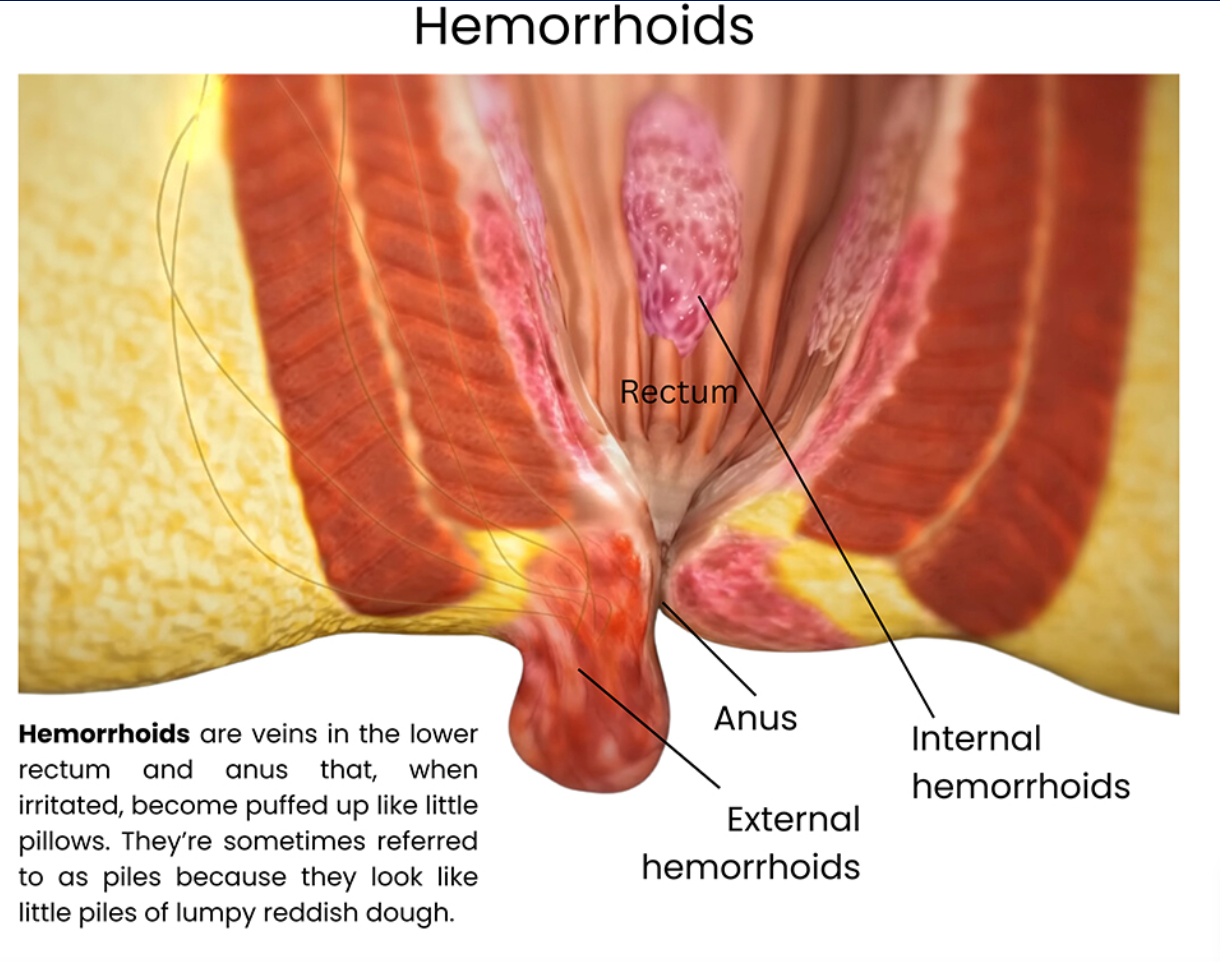
Hemorrhoids : Causes, Symptoms, Diagnosis, and Treatment
Definition
Hemorrhoids are dilated blood vessels in the hemorrhoidal plexus of the anal canal. They can be classified into external hemorrhoids, which occur below the dentate line and are covered by squamous epithelium, and internal hemorrhoids, located above the dentate line and covered by rectal mucosa. Hemorrhoids are common among adults and children and are often asymptomatic. When symptomatic, they may cause discomfort, irritation, or bleeding. In severe cases, thrombosed hemorrhoids can be painful and swollen.
Causes
The main cause of hemorrhoids is increased pressure in the veins of the anorectal area. Contributing factors include:
• Straining during defecation, often due to chronic constipation.
• Pregnancy, which increases pressure on pelvic veins.
• Heavy lifting or frequent activities requiring strain.
• Obesity, which elevates intra-abdominal pressure.
• Prolonged sitting or a sedentary lifestyle.
Rectal varices, which are distinct from hemorrhoids, may occur due to increased pressure in the portal vein and should be differentiated.
Symptoms and Signs
Hemorrhoids are often asymptomatic but can present with:
External Hemorrhoids
• Painful swelling when thrombosed, appearing as a purple, tender lump.
• Difficulty cleansing the anal area.
• Rarely, minor bleeding or ulceration.
Internal Hemorrhoids
• Bleeding during or after defecation, noted on toilet paper or in the bowl.
• Protrusion of the hemorrhoid, which may cause discomfort or a sensation of incomplete evacuation.
• Mucus discharge and mild irritation.
Strangulated Hemorrhoids
• Severe pain due to occluded blood supply.
• Possible necrosis and ulceration.
Prevalence
Hemorrhoids are highly prevalent and affect both men and women, particularly those over the age of 45. Factors such as pregnancy and chronic constipation increase the risk.
Diagnosis
Diagnosis is based on physical examination and anoscopy. Further evaluation with sigmoidoscopy or colonoscopy may be necessary to exclude other causes of rectal bleeding, such as colorectal cancer or inflammatory bowel disease.
• Anoscopy: Essential for painless or bleeding hemorrhoids.
• Physical Examination: Helps identify thrombosed or prolapsed hemorrhoids.
• Sigmoidoscopy/Colonoscopy: Used if there is suspicion of other serious conditions.

Internal hemorrhoids are classified by grade:
• Grade I: No prolapse, only visible on anoscopy.
• Grade II: Prolapse with straining, but reduce spontaneously.
• Grade III: Prolapse requires manual reduction.
• Grade IV: Irreducible prolapse with risk of strangulation.
Treatment
Treatment depends on the severity and symptoms of hemorrhoids.
1. Symptomatic Treatment
For mild cases, the following are often sufficient:
• Stool softeners: Such as docusate or psyllium, to ease bowel movements.
• Sitz baths: Sitting in warm water for 10 minutes after defecation to relieve discomfort.
• Topical treatments: Lidocaine ointments or witch hazel compresses to soothe irritation.
• Pain management: Nonsteroidal anti-inflammatory drugs (NSAIDs) for thrombosed hemorrhoids.
2. Office-Based Procedures
• Injection sclerotherapy: Injecting sclerosing agents like 5% phenol to stop bleeding.
• Rubber band ligation: Effective for Grades II and III hemorrhoids, this procedure involves placing a small rubber band around the base of the hemorrhoid to cut off blood supply, causing it to necrotize and slough off.
• Infrared photocoagulation: Used for bleeding internal hemorrhoids that do not respond to other treatments.
3. Surgical Options
• Surgical Hemorrhoidectomy: Reserved for Grade IV internal hemorrhoids or those unresponsive to other treatments. While effective, it is associated with significant postoperative pain, urinary retention, and constipation.
• Stapled Hemorrhoidopexy: An alternative for circumferential hemorrhoids, with less pain but higher recurrence rates.
• Doppler-Guided Hemorrhoid Artery Ligation: A promising technique that uses ultrasound to identify and ligate hemorrhoidal arteries.
Signs That Require Immediate Attention
• Persistent or significant rectal bleeding: This could indicate more serious conditions such as colorectal cancer.
• Severe pain: Especially if associated with a thrombosed or strangulated hemorrhoid.
• Prolonged prolapse: Risk of strangulation or infection.
• Signs of infection: Fever, swelling, or pus discharge.
In such cases, it is essential to seek medical attention promptly.
Prevention
• High-fiber diet: Incorporate fruits, vegetables, and whole grains to soften stools and reduce straining.
• Stay hydrated: Drink plenty of water to promote regular bowel movements.
• Avoid prolonged sitting: Take breaks and stay active throughout the day.
• Exercise regularly: Helps prevent constipation and improves circulation.
• Proper bowel habits: Avoid straining or sitting on the toilet for extended periods.

What to Do Next?
If you experience any symptoms of hemorrhoids, download our app for guidance on how to manage your condition and find medical support. Our platform provides expert advice, connects you to healthcare professionals, and helps you track your symptoms for better management. Don’t wait—take control of your health today!
For severe or persistent symptoms, consult a doctor for further evaluation and tailored treatment options.
